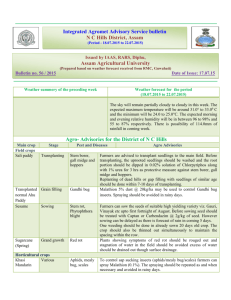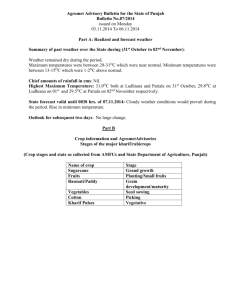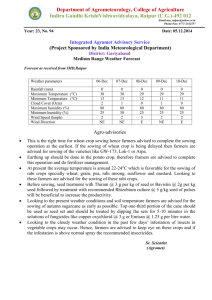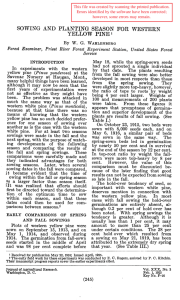FALL SOWING AND DELAYED ... WESTERN WHITE PINE SEED
advertisement
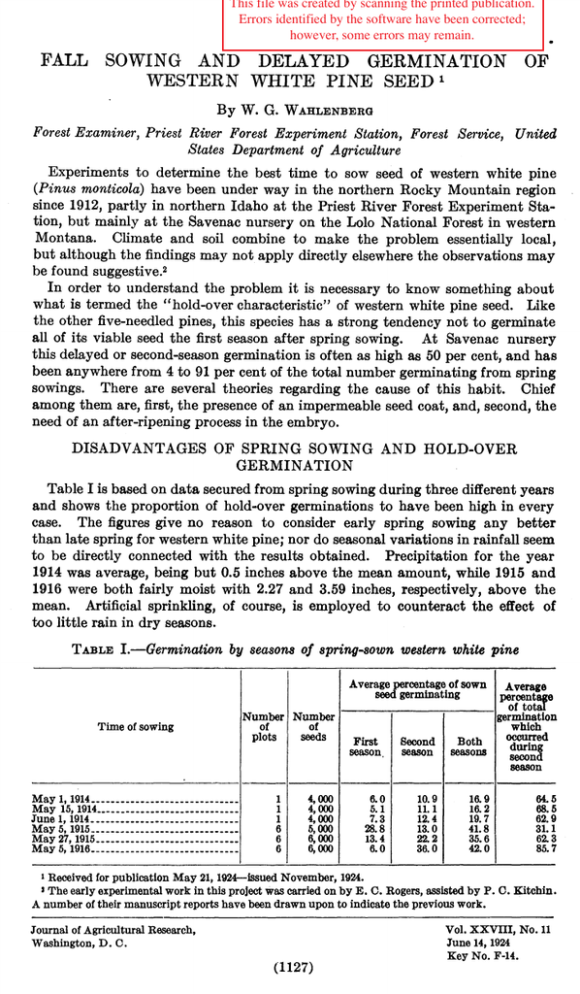
This file was created by scanning the printed publication. Errors identified by the software have been corrected; however, some errors may remain. FALL SOWING AND DELAYED GERMINATION WESTERN WHITE PINE SEED1 OF By W. G. WAHLENBERG Forest Examiner, Priest River Forest Experiment Station, Forest Service, United States Department of Agriculture Experiments to determine the best time to sow seed of western white pine (Pinus monticola) have been under way in the northern Rocky Mountain region since 1912, partly in northern Idaho at the Priest River Forest Experiment Station, but mainly at the Sa venae nursery on the Lolo National Forest in western Montana. Climate and soil combine to make the problem essentially local, but although the findings may not apply directly elsewhere the observations may be found suggestive.2 In order to understand the problem it is necessary to know something about what is termed the " hold-over characteristic" of western white pine seed. Like the other five-needled pines, this species has a strong tendency not to germinate all of its viable seed the first season after spring sowing. At Savenac nursery this delayed or second-season germination is often as high as 50 per cent, and has been anywhere from 4 to 91 per cent of the total number germinating from spring sowings. There are several theories regarding the cause of this habit. Chief among them are, first, the presence of an impermeable seed coat, and, second, the need of an after-ripening process in the embryo. DISADVANTAGES OF SPRING SOWING AND HOLD-OVER GERMINATION Table I is based on data secured from spring sowing during three different years and shows the proportion of hold-over germinations to have been high in every case. The figures give no reason to consider early spring sowing any better than late spring for western white pine; nor do seasonal variations in rainfall seem to be directly connected with the results obtained. Precipitation for the year 1914 was average, being but 0.5 inches above the mean amount, while 1915 and 1916 were both fairly moist with 2.27 and 3.59 inches, respectively, above the mean. Artificial sprinkling, of course, is employed to counteract the effect of too little rain in dry seasons. TABLE I.—Germination by seasons of spring-sown western white pine Average percentage of sown seed germinating Time of sowing May 1,1914 .. May 15,1914. June 1,1914.. May5,1915. . May 27,1915. May 5,1916.. Number Number of of plots 6 4,000 4,000 4,000 5,000 6,000 6,000 First 6.0 5.1 7.3 28.8 13.4 6.0 Second season 10.9 11.1 12.4 13.0 22.2 36.0 Both 16.9 16.2 19.7 41.8 35.6 42.0 Average percentage of total germination which occurred during second 64.5 68.5 62.9 31.1 62.3 85.7 i Received for publication May 21,1924—issued November, 1924. The early experimental work in this project was carried on by E. C. Rogers, assisted by P. O. Kitchin. A number of their manuscript reports have been drawn upon to indicate the previous work. 1 vol. xxvni, No. 11 June 14,1924 Key No. F-14. Journal of Agricultural Research, Washington, D. C. (1127) 1128 Journal of Agricultural Research vol. xxvm, No. n It is very desirable to eliminate this hold-over germination for several reasons. The most obvious objection is that a very irregular stand of seedlings is produced. The seed-bed stand is uneven-aged, uneven in size, and uneven in its resistance to injury. Such irregular stands require heavy culling at the end of the second season or must be kept through the third season with its additional costs for all cultural operations. Either course is undesirable and expensive. Together with hold-over germination we have to deal with a first-season germination from spring sowings which extends its activity throughout the summer. This aggravates the difficulties just mentioned, particularly the poor resistance. Seedlings originating late in the season are young and tender, and so undergo heavy losses. Death from the damping-off fungi is confined to seedlings three weeks old or less. Young seedlings are scorched by the hot sun of July and August and die more easily from slight drying of thé surface soil than do their companions which are a month or two older. This necessitates the heavy expense of shading the seed-beds with lath frames. Then often 20 to 25 per cent of these weak, not yet lignified individuals are lost over winter. Frost heaves the ground in late fall or early spring when the soil is moist and exposed, and the weaker seedlings are heaved out. To avoid this trouble mulching the beds with straw or similar material is necessary, but this in turn results in the breaking of tender stems while applying and removing mulch. In the endeavor to obviate these difficulties many attempts have been made to hasten the germination of the western white pine seed, among which may be mentioned: Stratification, sowing fresh seed, soaking in hot or cold water or in acids of different concentrations, dry and moist freezing, sowing in hotbeds, sowing of pregerminated seed, and mechanical methods of cracking, piercing, abrading or removing the seed coat. Most of these, however, are dangerously artificial methods which, experience has shown, tend to lower germinative capacity and at the same time do not uniformly accelerate germination.3 FALL- VERSUS SPRING-SOWING EXPERIMENTS Because the results of these trials of spring sowing were all quite unsatisfactory, the possibility of fall sowing was considered. If the hold-over germination could thus be avoided the disadvantage of exposing newly made seed-beds for a longer time to the ravages of bird and rodent enemies, and to frost heaving of seed would be compensated for or could be controlled by other means. In actual practice the losses due to these causes have been small. During the growing seasons from 1914 to 1916 at the Priest River Forest Experiment Station, observations concerning the best season to sow were taken from plots sown for other studies. In one instance, fall-sown plots had conpleted 83 per cent of their total germination before the end of May, while less than 14 per cent of the germination in spring-sown plots was complete at that time. Again fall sowings were 17 per cent higher in survival, and produced larger stock in every respect. In the fall of 1913 and spring of 1914 at Savenac nursery six plots, each containing 2,000 counted seeds, were sown on different dates. Germination from fall-sown plots was complete about 15 days before that from spring-sown plots started. (See fig. 1.) Twelve plots sown on October 27 and November 4, 1915, and on May 5, 1916, were watched during 1916. Hold-over germinations were much more numerous from spring sowing. Subsequent work has constantly given similar results. (See fig. 2 and 3.) * A full discussion of this subject is given in a manuscript thesis presented in 1917 to the faculty of the Graduate School of Cornell University: ROGERS, E. C. DELAYED GERMINATION AMONG THE FIVENEEDLE PINES. Western White Pine Seed June 14, 1924 1129 IMPORTANCE OF DATE OF FALL SOWING The superiority of fall over spring sowing of this species was so marked in the early experiments that it seemed as if the problem were solved, but it soon appeared that the correct time in the fall season for doing the sowing was also very important. l\ o 60 <fc 70 Ss.SO O b20 Si BASIS:-500 SEEDS IN EACH LOT \ Ç60 l*\ \ /] \ i \ ¡i — SOWN OCT. 1,1913 SOWN MAY 1, 1914 SOWN MAY 15, 1914 SOWN JUNE I,iai4 [ 1 \ 1 \\ s\ 5 10 / /-*' L_ io 20 ^ «/ .^2"- ^ ^ii. ...^ >- A ^ ^-—. strsz ^ SaJ io zo qp 10 zo ^ lo 20 3j 10 lo q> 10 MAY JUNE JULY AUG. SEPT. OCT. DATES OF EXAMINATIONS FIG. 1.—Germinativo energy of western white-pine seed at Savenac Nursery as influenced by season of sowing ¿MTf OFSOW/NG FIG. 2.—Results of sowing of Kaniksu seed, 1917 » In the fall of 1916, at 10-day intervals from August 21 to October 28, twentyeight plots of 1,000 seeds each were sown. From the results of this series early fall sowing is indicated as best, in order to reduce to a minimum the germination occurring after the month of June; but a different seed lot, germinating the highest total number, yielded only a small number of germinations after June 30» even from late sowings. Based on the highest number of seedlings germinating promptly the first season, September 1 was the optimum time to sow in 1916. 96462—24f 6 1130 Journal of Agricultural BesmrcJi vol. xxvm, No. n In the fall of 1917 sowings were made on September 7, 17, 27; October 6, 20, and November 3, with two lots of seed; 24,000 seeds were sown in samples of 1,000. These series showed no startling differences in September sowings, but the October sowings were inferior in promptness of germination and total numbers appearing the first season. During the fall of 1918, fourteen samples of 1,000 seeds each were sown on various dates, utilizing seed from two sources. The first three weeks in September appear to have been the proper time to sow that year. The degree of promptness of germination was quite satisfactory for all of the first four sowings (August 27, September 9 and 21, and October 1), germination being practically all confined to the month of May. The graphs (fig. 2 and 3) show the total germinations and the proportion of hold-over. No seedlings were lost from "premature" germination; or, in other words, no seeds germinated during the fall of sowing ¿MTZ OFSOW/m FIG. 3.—Results of sowing of Washington seed, 1917 only to succumb during winter. Except for the factor of germinative energy, or seasonal promptness, the graphs illustrate the essential points to consider in this problem, and appear to be typical of what may ordinarily be expected. The results of spring sowing on two different dates are also shown for the sake of comparison. SUMMARY OF ADVANTAGES OF FALL SOWING Fall sowing of western white pine results in prompt and complete germination the following spring. Thus a regular and full stand of seedlings is secured. The heavy culling otherwise necessary, or its alternative of keeping the stock another year, is avoided. No shade or mulch at all is necessary, hence the entire cost of these three operations is saved. Handling the lath shade-frames was formerly a large item, because they had to be removed and replaced several times a season for weeding operations. A cost of $66 for straw and $181.50 for the frames and handling them is now saved each year at the Savenac Nursery as a result of these experiments. In short, it appears that we have avoided completely all of the disadvantages of spring sowings and hold-over germinations. Western White Pine Seed June 14, 1924 1131 Figure 4 indicates that the best time in the fall for sowing western white pine seed at the Sa venae nursery is during the first two weeks in September. According to the curve, the last few days in August may be as good, but this is no^ 1 ■r II 12 II CO 50 Ss^^ %s ^ vs^ ^ V¡' \ • 30 v II1 1 1 ANDS OF 55EED SOWN 13 L^~^ A 10 0 ^ 3.0 AUG. FIG. 1 \ ! I 1 BASED ON THE RESULTS OF SOWING A TOTAL OF 77,000 COUNTED SEEDS DURING THE YEARS 1916 TO 1920. FIGURES ON THE GRAPH REPRESENT 10 20 JSL 10 SEPT. OCT. DATES OF SOWING 20 J9LJ NOV. 4.—Germination of western white pine seed at Savenac nursery as influenced by time of sowing in the fall certain. Trial sowings in August have not been numerous enough to fix the direction of the curve at that end. Furthermore, August sowings are subject to premature germination; that is, germination during the fall of sowing; and seedlings germinating prematurely do not survive the winter.

